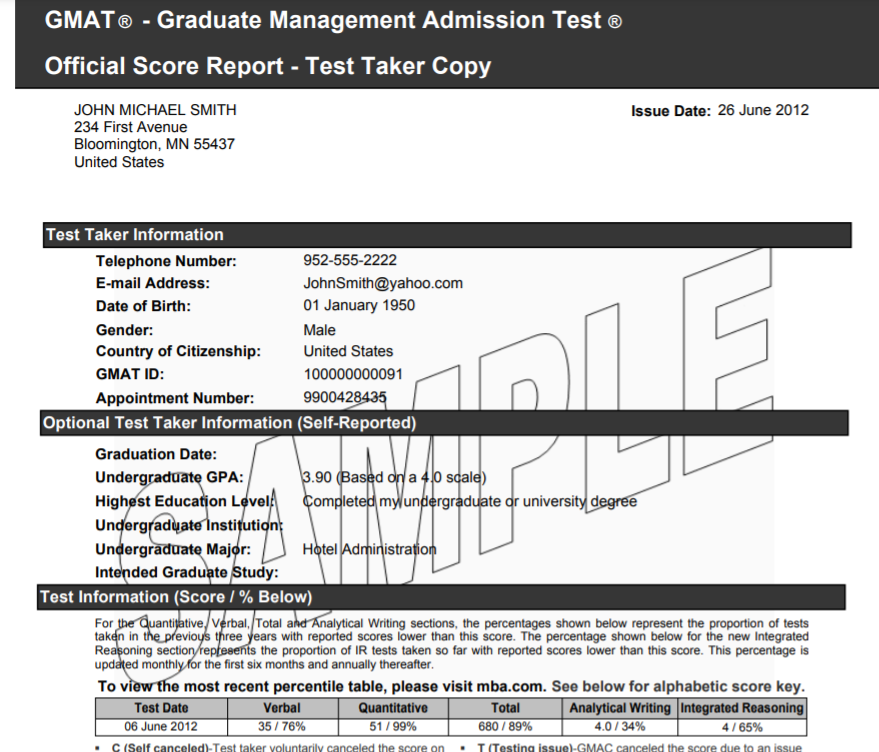After burning midnight oil for months together, achieving a good GMAT exam score is the end of the rope for students. A good GMAT score opens you up to endless opportunities. Any Business school graduate or an MBA aspirant can boost their careers, amplify their business knowledge, land attractive packages by graduating from a good University. Top universities across the World accept students based on their GMAT scores. This in turn helps in pursuing your desired course in a top notch college.
Must read: Did you know that GMAT can be attempted from the comfort of your home?
GMAT Scoring Pattern: The Four Pillars Of the GMAT Test
Essentially, the aim of the GMAT exam is to check your overall English language finesse, logical reasoning skills and decision-making ability. As you have four sections in the GMAT test to answer, you are presented with each of them separately in your GMAT scorecard. However, the Verbal Reasoning score and the Quantitative Reasoning score combined give to the total GMAT score.
Let’s look at each section and the score scale of each of them below:
|
GMAT Section |
Scoring |
|---|---|
|
0-6 score scale, with 0.5 increments |
|
|
1-8, with 1 point increment |
|
|
6-51 score scale, with 1 point increment |
|
|
6-51 score scale, with 1 point increment |
-
The Verbal Reasoning section and the Quantitative Reasoning section are computer-adaptive. This implies that the difficulty level of the GMAT questions changes based on the correctness of your answers.
-
The Analytical Writing task and Integrated Reasoning section of GMAT have set questions and aren’t computer adaptive. They are also separately presented in the same GMAT scorecard but do not add up to your GMAT total score.
Decoding GMAT Section Scoring - The easy way!
Verbal Reasoning scores + Quantitative Reasoning scores = GMAT Total Score
Verbal and Quantitative sections of GMAT are scored on a 6-51 score scale with one point increment. The sum of both of these sections is marked as your GMAT total score in the range of 200 - 800, with a 10 points increment.
The scoring of these sections vary due to their computer-adaptive nature. Implying that:
-
You’re scored on the number of questions answered.
-
The number of correct answers given.
-
The difficulty level of each of the questions answered.
Integrated Reasoning Scoring: This section of GMAT is marked on a 1-8 score scale with a single-digit interval.
-
Remember! Each of the IR questions in the GMAT has various parts. It is a must to answer all the parts correctly to grab a score.
-
There are no scores given for partially correct answers.
Analytical Writing Scoring: In this section of the GMAT, you have one essay task to complete. The essay is scored by a human rater and a machine algorithm. In case of score disparities, another approved human rater rechecks your essay and adjusts the scores.
-
Your essay is scored on a 0-6 score scale, with 0.5 intervals.
-
If you’re unsatisfied with your essay score, you can request for re-evaluation within 20 days of receiving your official scorecard.
Verbal Reasoning, Quantitative Reasoning and Integrated Reasoning scores cannot be re-evaluated.
PAY ATTENTION! Acceptance of GMAT score after the test
Immediately after taking the GMAT test you will receive an unofficial GMAT result. You’re supposed to make the decision of either accepting or cancelling your scores within 2 minutes.
Failing to accept your scores within 2 minutes automatically cancels your GMAT scores. Hence, it is important for you to set the GMAT score range you aim to achieve in order to get an admission to your desired college.
Let’s now understand one of the most common dilemmas faced by students around the GMAT exam results -
Many aspirants get perplexed by the GMAT score reporting of percentages. Also, a few have confusion around negative marking in GMAT.
It needs to be pointed out right at the outset that there is absolutely no negative marking in the GMAT exam. However, since the exam is adaptive in nature, the questions keep getting tougher if the ones you answered are correct. On the other hand, if your attempted questions are incorrect, the next set of questions are easy.
Since lakhs of test takers across the world attempt GMAT which is computer adaptive, it is highly unlikely for percentages to be calculated. However, the GMAT score reporting sheet reflects GMAT percentiles.
So, how are the GMAT scores and percentiles calculated?
Let’s find out -
How are GMAT scores and percentiles calculated?
Scoresheets include GMAT percentiles. This number indicates the percent of test takers that you performed better than in the exam.
For instance - A ranking of 75% means that 25% of test takers performed as well or better than you and 75% did not perform as well.
Remember: Your scores do not change. However, the GMAT scoring pattern of percentile rankings may change as they are recalculated every summer using the test takers data from the previous three years.
Here’s one of the tabulation you can refer to check the GMAT overall score and percentile ranking ranges you might find yourself in:
|
Scaled Score |
Percentile Ranking |
|---|---|
|
760-800 |
99 |
|
710-750 |
92-98 |
|
660-700 |
80-89 |
|
550-650 |
77-49 |
|
460-540 |
22-43 |
|
360-450 |
8-20 |
|
200-210 |
0 |
What is a good GMAT Score for you to make it to a Top University?
Experts say that a GMAT score range anywhere from 650-690 makes for a good score. However, surpassing the good GMAT score for a better 700, 760 or an out-of-out 800 is a great score.
Here’s a list of some of the top universities across the world along with the average score you will need to bag a seat:

Moving forward, let’s look at the different types of GMAT scorecards.
GMAT Scoreboard: Your Toll Ticket To Your Dream College
Have easy access to top US universities with Yocket’s Grad School Finder
GMAT scorecards are an important asset for students aspiring to study abroad. Every GMAT aspirant receives the following GMAT scorecards -
-
Unofficial scorecard
-
Official GMAT scorecard
-
Enhanced scorecard (Can be purchased)
Unofficial GMAT Scorecards
Candidates taking the aptitude test receive their Unofficial GMAT exam result on the test day. After the completion of your test, an unofficial total score appears on your screen. By accepting this score, you successfully accept your GMAT test.
-
If you accept the GMAT Unofficial scores at the test center, you will receive a printed hard copy of the same before you leave. The official results will be mailed to you at your registered address or emailed within 20 days after the examination.
-
In the case of GMAT Online, your unofficial scores are displayed on the screen after the completion of your test. The official results will be available on your official mba.com account within seven days of writing the test.
The Unofficial GMAT Scorecard comprises of the following:
-
Personal details: Name, Address
-
Test details: Test date, Appointment number, GMAT ID number
-
Scores: Verbal Reasoning score, Quantitative Reasoning score and GMAT total score

Source: mba.com
Official GMAT Scorecards
Test takers receive their official results within a week to 20 days after the test. The GMAT results are mailed to your address or can also be viewed on your official MBA GMAT account.
The Official GMAT Scorecard comprises of the following:
-
Test taker’s Personal details: Name, Address, Phone number etc.
-
Optional information: Details of graduation and post-graduation.
-
Scores: Verbal Reasoning score, Quantitative Reasoning score, Total score, Integrated Reasoning score, Analytical Writing score and the percentages of each of these sections respectively.

Enhanced GMAT Scorecards
This is an exclusive GMAT scorecard which is purchased. This isn’t sent to each of the test takers individually. Rather, test takers can buy it from the official website with an additional cost of US $30.
How to view your GMAT scores online?
By logging in to your personal GMAT account on mba.com, you can stay updated with all the test related communications as well as view or send scores to various universities.
The enhanced score card holds detailed information of your GMAT performance. It includes scores, strengths and weaknesses, answering pace, area of expertise and also, areas that have room for improvement. This scorecard acts as a guiding torch of detailed information based on your performance.
How to send GMAT scores to schools?
You can send your GMAT scores to various universities for FREE via mba.com. Follow this process while sending your GMAT scores to Business Schools:
-
Login to your mba.com account
-
Navigate to send scores on your personal GMAT account
-
Select the course/colleges you wish to send your scores to and hit on SEND SCORES!
Validity of GMAT scores - A point of perplexity amongst aspirants
Are you planning to take the GMAT test but are caught in a dilemma of applying this year or next?
The GMAT score valid up to 5 years will provide ample time for you to apply to your desired colleges.
For instance, If you have taken the test on 2-1-2024, GMAT score is valid up to 2-1-2025. Hence, from now on, you don’t have to beat yourself up with the confusion w.r.t GMAT valid score timeline.
Canceling your GMAT scores
What if you need to ‘Crop’ or ‘Ctrl Z’ your GMAT test scores? It’s okay. We got you!
As mentioned in this article earlier, you are given two minutes to decide whether to cancel or accept your GMAT score. If the time expires before you make your decision, the score gets cancelled automatically.
In case you accepted your scores at the center but wish to change it, you can. You have the option to cancel your accepted score online up to 72 hours after the completion of your exam.
What happens once your GMAT scores are cancelled?
Once your scores are cancelled:
-
Your scores will not be sent to any of the schools you selected.
-
You will not receive a printed copy of your unofficial scores at the test center.
-
You will not be able to access your official score report.
What does it mean to reinstate your GMAT score?
-
Canceled scores can be reinstated up to four years and 11 months from the exam date.
-
If a score is reinstated, the score report will be sent to the initial list of schools that you selected on the test day. You cannot modify the list. You will, however, be able to view the list of schools receiving your reinstated score prior to confirming the reinstatement.
Q: Can GMAC cancel your scores? If yes, then how would you know?
Ans: Yes, GMAC can cancel your test scores. They mention their reasons for doing the same. You can view the reasons by signing in to your GMAT account.
If scores have been cancelled because of ‘T’ or ‘Testing issues’, this might be due to registration issues, payment issues, test disclosure etc.
Cancellation due to ‘P’ or ‘Policy Issues’, you might have committed a policy violation.
Cancellation due to ‘S’ or ‘Serious policy violation’, implies that you committed a serious violation.
Taking an international competitive examination can be overwhelming. However, if you understand the nature of GMAT that evaluates you on an intellectual level, you have nothing to worry about. GMAT will open up your options for getting admitted to good universities which in turn look forward to talented students with a plan. A well prepared GMAT aspirant aces the test gracefully. All you have to do to get there is to prepare yourself in each of the GMAT sections of Verbal Reasoning, Quantitative Reasoning, Integrated Reasoning and Analytical Writing, in a timely manner. Your preparation will indeed lead to winning results.
All the Best!





























